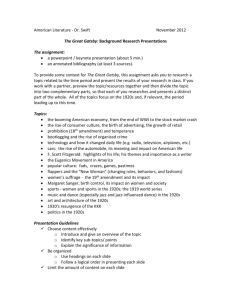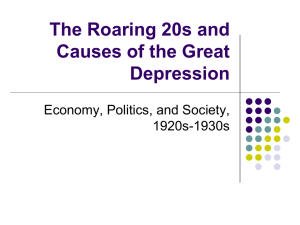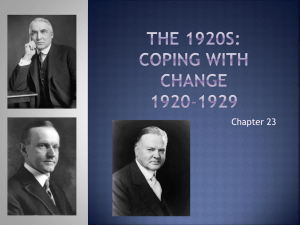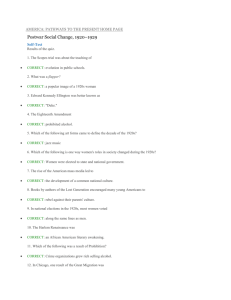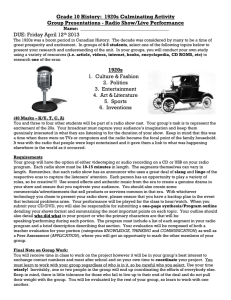1920s Consumer Culture
advertisement
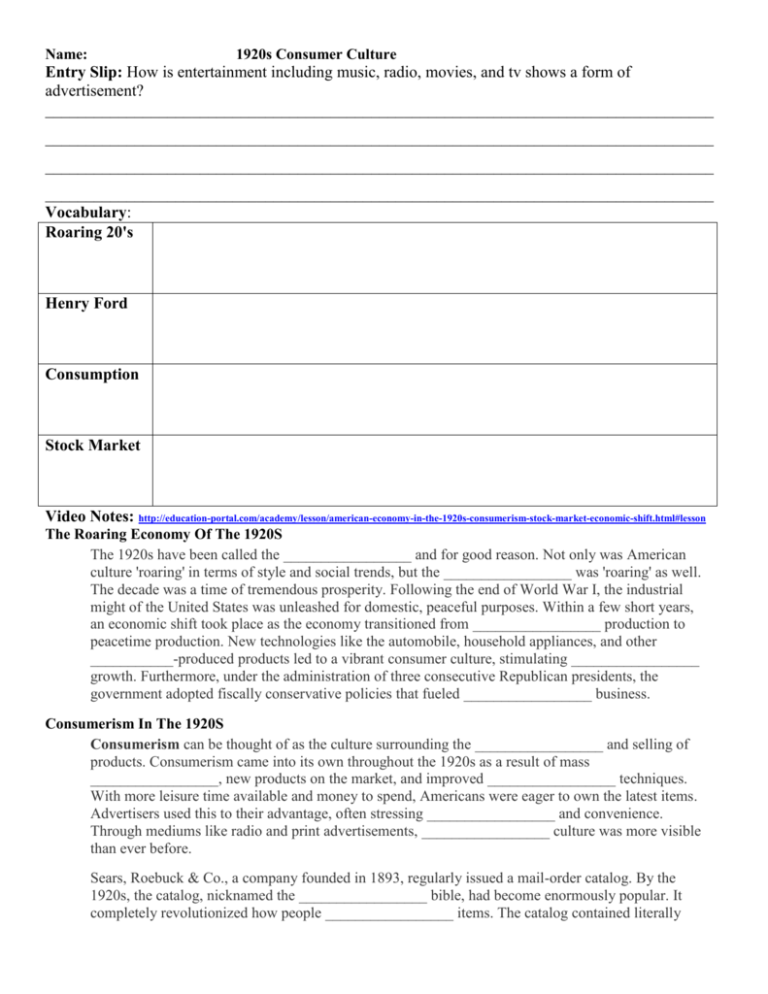
Name: 1920s Consumer Culture Entry Slip: How is entertainment including music, radio, movies, and tv shows a form of advertisement? __________________________________________________________________________________ __________________________________________________________________________________ __________________________________________________________________________________ __________________________________________________________________________________ Vocabulary: Roaring 20's Henry Ford Consumption Stock Market Video Notes: http://education-portal.com/academy/lesson/american-economy-in-the-1920s-consumerism-stock-market-economic-shift.html#lesson The Roaring Economy Of The 1920S The 1920s have been called the _________________ and for good reason. Not only was American culture 'roaring' in terms of style and social trends, but the _________________ was 'roaring' as well. The decade was a time of tremendous prosperity. Following the end of World War I, the industrial might of the United States was unleashed for domestic, peaceful purposes. Within a few short years, an economic shift took place as the economy transitioned from _________________ production to peacetime production. New technologies like the automobile, household appliances, and other ___________-produced products led to a vibrant consumer culture, stimulating _________________ growth. Furthermore, under the administration of three consecutive Republican presidents, the government adopted fiscally conservative policies that fueled _________________ business. Consumerism In The 1920S Consumerism can be thought of as the culture surrounding the _________________ and selling of products. Consumerism came into its own throughout the 1920s as a result of mass _________________, new products on the market, and improved _________________ techniques. With more leisure time available and money to spend, Americans were eager to own the latest items. Advertisers used this to their advantage, often stressing _________________ and convenience. Through mediums like radio and print advertisements, _________________ culture was more visible than ever before. Sears, Roebuck & Co., a company founded in 1893, regularly issued a mail-order catalog. By the 1920s, the catalog, nicknamed the _________________ bible, had become enormously popular. It completely revolutionized how people _________________ items. The catalog contained literally Name: 1920s Consumer Culture hundreds of pages featuring products like sewing machines, bicycles, clothing, radios, and just about everything else imaginable. _________________ buying, or buying on _________________, was also popular, allowing families to purchase large items like automobiles or refrigerators and pay them off _________________ over a period of time. Large _________________ stores also became popular during this time. Document 1: Henry Ford and the Automobile Perhaps the greatest increase in efficiency came when Henry Ford perfected the assembly-line production method, which enabled factories to churn out large quantities of a variety of new technological wonders, such as radios, telephones, refrigerators, washing machines, and cars. The increasing availability of such consumer goods pushed modernization forward, and the U.S. economy began to shift away from heavy industry toward the production of these commodities. The automobile quickly became the symbol of the new America. Although Americans did not invent the car, they certainly perfected it. Much of the credit for this feat went to Ford and his assembly-line method, which transformed the car from a luxury item into a necessity for modern living. By the mid1920s, even many working-class families could afford a brand-new Model T Ford, priced at just over $250. Increasing demand for the automobile in turn trickled down to many other industries. The demand for oil, for example, boomed, and oil prospectors set up new wells in Texas and the Southwest practically overnight. Newer and smoother roads were constructed across America, dotted with new service stations. Change came so rapidly that by 1930, almost one in three Americans owned cars. What is the Author's Purpose in Document 1? __________________________________________________________________________________ __________________________________________________________________________________ __________________________________________________________________________________ Who was Henry T. Ford AND how did his invention change American Culture in the 1920s? __________________________________________________________________________________ __________________________________________________________________________________ __________________________________________________________________________________ ___________________________________________________________________________________ ___________________________________________________________________________________ ________________________________________________________________________________ Name: 1920s Consumer Culture Document 2: Mass Consumption and Mass Culture The culture of the 1920s grew out of the material abundance of the new mass-production/mass-consumption economy, which generated both increased wages for the urban middle class and fabulous profits for wealthier investors. Even as wondrous new machines transformed the conditions of everyday life, culture itself became a mass commodity. The 1920s were the heyday of broadcast radio and Hollywood cinema; for the first time, consumers across the country tuned in to the same radio programs and bought tickets to the same films. Advertising became a crucial industry in its own right, cultivating mass demand for the products of mass consumption. What is the Author's Purpose in Document 2? __________________________________________________________________________________ __________________________________________________________________________________ ___________________________________________________________________________________ _________________________________________________________________________________ __________________________________________________________________________________ How do the radio and Hollywood cinema create a culture of “consumption” in the 1920s? __________________________________________________________________________________ __________________________________________________________________________________ __________________________________________________________________________________ __________________________________________________________________________________ __________________________________________________________________________________ __________________________________________________________________________________ Document 3: A Great Time to be Rich Name: 1920s Consumer Culture The 1920s' reputation as the perfect example of wretched excess may have been unfair by the devastating portrait of life among the rich provided by F. Scott Fitzgerald's classic novel, The Great Gatsby. But the Roaring Twenties were, in fact, a great time to be rich. Meanwhile, the explosion in new massproduction industries fueled by the spread of technologies like electricity and the assembly line provided ample opportunities for profitable investment, and the stock market began its famed ascent. With money to invest, many Americans began buying stock. This was the thing to do in the 1920s. It was seen as modern: a venture for those who were smart, sophisticated, and urbane. And while it carried risks, it was generally seen as a sound investment. As the economy continued to grow throughout the decade, some people came to see investing in stock as a foolproof way to get rich quick. Since less than 1% of the American people owned any stock, those fabulous returns in the stock market directly benefited only the wealthy. As a result, the share of America's wealth controlled by the richest of the rich increased rapidly to perhaps the highest level in American history. In any case, the Roaring Twenties offered a classic case of the rich getting richer. Much richer. What is the Author's Purpose in Document 3? __________________________________________________________________________________ __________________________________________________________________________________ __________________________________________________________________________________ __________________________________________________________________________________ How did the stock markets contribute to the creation of the upper class in the 1920s? __________________________________________________________________________________ __________________________________________________________________________________ __________________________________________________________________________________ __________________________________________________________________________________ __________________________________________________________________________________ __________________________________________________________________________________


